- Home
- »
- Consumer F&B
- »
-
Gluten-free Baking Mixes Market Size & Share Report, 2030GVR Report cover
![Gluten-free Baking Mixes Market Size, Share & Trends Report]()
Gluten-free Baking Mixes Market Size, Share & Trends Analysis Report By Product (Cookies, Cakes & Pastries, Bread, Pizza), By Distribution Channel, By Region, And Segment Forecasts, 2024 - 2030
- Report ID: GVR-4-68039-430-4
- Number of Report Pages: 96
- Format: PDF, Horizon Databook
- Historical Range: 2018 - 2022
- Forecast Period: 2020 - 2030
- Industry: Consumer Goods
Gluten-free Baking Mixes Market Trends
The global gluten-free baking mixes market size was estimated at USD 481.9 million in 2023 and is projected to grow at a compound annual growth rate (CAGR) of 7.8% from 2024 to 2030. The increasing prevalence of celiac disease, non-celiac gluten sensitivity, and rising demand for convenient healthy food items is anticipated to drive the demand for the product over the forecast period. Bakery products are mainly prepared using wheat; however, the high quantity of gluten in the grain has been limiting its utilization. Wheat is, therefore, being replaced with various grains and pulses like quinoa, gluten-free baking mixes, amaranth, teff, corn, brown rice, buckwheat, and sorghum. The mixes are available for various bakery products—including bread, muffins, pizzas, donuts, and cakes.
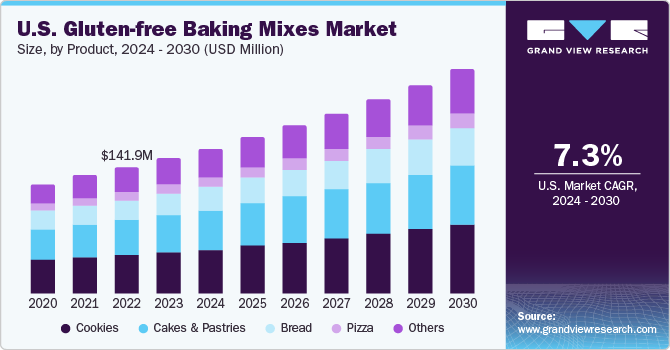
Countries including the U.S., Germany, and the UK are the major consumers of bakery products in the world. The increasing prevalence of celiac disease and irritable bowel syndrome (IBS) in these countries is the primary factor fueling product demand.
Lately, many health-conscious people who do not suffer from celiac disease, gluten intolerance, or gluten sensitivity are also making a sensible effort to avoid gluten-containing foods from their diet. Moreover, the growth of the consumption of bakery foods worldwide coupled with rising health consciousness, especially among millennials and Gen Z, is driving the market.
With the growing demand for gluten-free foods, key brands offering baking mixes are employing a progressive approach to keep up with current trends. Companies have been increasingly expanding their consumer base by extending their geographical reach. For instance, in June 2023, Aldi Stores Limited announced the testing of its own LiveGfree brand’s gluten-free products at locations across the U.S.
Market Concentration & Characteristics
The demand for gluten-free products has been driven by various factors, including an increase in gluten-related disorders, changing consumer preferences toward healthier lifestyles, and a broader awareness of gluten-free diets. Food manufacturers were actively working on developing new and improved gluten-free products, including baking mixes, to meet the evolving needs of consumers.
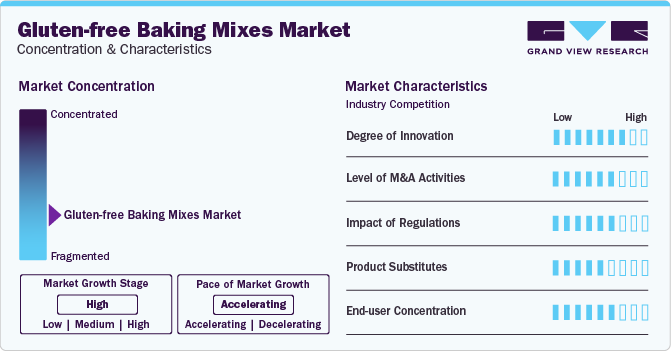
Innovations in this market have included the use of alternative flours and ingredients, improvements in taste and texture, and the development of gluten-free products that replicate the qualities of traditional baked goods. Additionally, there were advancements in packaging, marketing strategies, and collaborations with health and wellness influencers.
Several market players such as General Mills Inc., Conagra Brands, Inc., Kinnikinnick Foods Inc. are involved in merger and acquisition activities. Through M&A activity, these companies can expand their geographic reach and enter new territories.
Clear and strict regulations on gluten-free labeling and ingredient standards can increase consumer trust in the products, boosting overall market growth. This is especially important for individuals with Celiac disease or severe gluten sensitivity, who rely on accurate labeling for their health.
Almond flour is a popular gluten-free alternative that adds a nutty flavor to baked goods. It's rich in protein and low in carbohydrates.
Coconut flour is another gluten-free option that provides a subtle coconut flavor. It's high in fiber and low in carbohydrates.
Product Insights
The cookies segment accounted for the largest revenue share of 32.6% in 2023 and is anticipated to maintain its dominance over the forecast period. The rising popularity of cookies among toddlers, children, millennials, and even the working population as a snack, is the major factor driving the growth of this segment. Furthermore, cookies are also gaining traction as a gifting option during celebrations and festivals such as Christmas, New Year, and Thanksgiving favoring the segment growth.
Major players are launching new products in the market with the rising demand for gluten-free cookies across the globe. For instance, in November 2023, Nabisco, a subsidiary company of Mondelez International, announced the launch of two varieties of gluten-free cookies under the Oreo brand. The Oreo Gluten-Free cookies and Oreo Double Stuf Gluten-Free cookies were available in stores in the U.S. from January 2021.
The bread segment is expected to grow at a substantial rate of 8.1% over the forecast period. Bread is widely consumed worldwide. However, the rising trend of low-carbohydrate diets put a dent in bread consumption. Thus, manufacturers are launching gluten-free bread mixes in the market so that customers can enjoy home-cooked healthy breads.
Distribution Channel Insights
The grocery stores accounted for the largest revenue share of around 63.6% in 2023. The presence of numerous grocery stores across all big and small economies is driving the demand through this channel. Over the past few years, major players in the supermarket industry have been focusing on expanding their footprint globally by opening new stores and strengthening delivery centers.
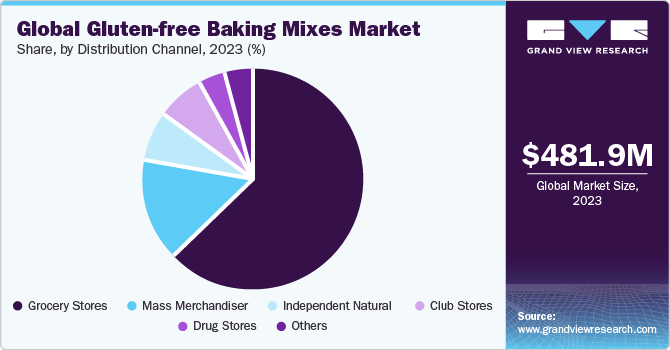
For instance, in September 2023, Wm Morrison Supermarkets plc, one of the leading supermarkets in the U.K., announced that it would hire thousands of more permanent staff as the company expands its online delivery service. These market trends are increasing product sales through grocery stores.
The other segment which includes e-commerce platforms and online portals is expected to ascend at the fastest CAGR over the forecast period. Over the past few years, players in the FMCG industry have realized the potential of e-commerce and hence host their shopping websites to better cater to their customers’ needs and earn a higher profit margin.
Third-party sellers offer a wide range of products, manufactured by both major companies and local producers. These sellers are successful since they establish a strong supply chain that extends beyond geographical borders. Thus, when customers want to buy products from international players, that might not be available in a certain country, third-party suppliers are the ideal option.
Regional Insights
North America accounted for the largest share of over 40.3% of the market revenue in 2023 and is expected to continue its dominance over the forecast period. The U.S. accounted for the largest revenue share in the region owing to rising consumers’ willingness to try new variants of food, such as gluten-free, vegan, and sugar-free.
Growing awareness regarding the possible side effects of gluten on one’s health is also anticipated to continue driving the regional demand. High prevalence of celiac disease in the U.S. is boosting awareness levels among consumers, which, in turn, is expected to bode well for the market over the forecast period.
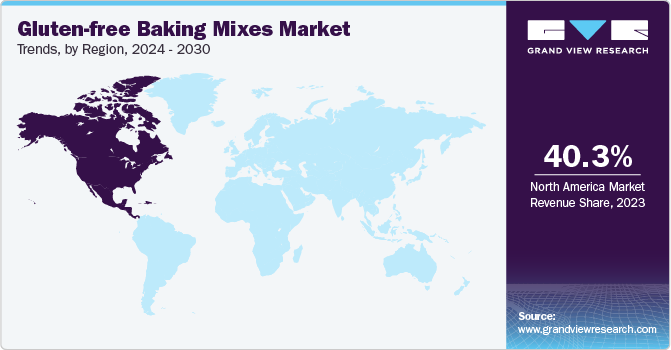
Asia Pacific is anticipated to gain limelight owing to the rising demand for healthy food items and the increasing adoption of a healthy lifestyle among consumers in China, Australia, Japan, and India. Moreover, an increase in the rate of allergic diseases and other gluten-related diseases is propelling this market’s growth.
The rising consumer awareness about the consequences of gluten consumption in the region will enhance the adoption of the product in the upcoming years. Furthermore, the increasing popularity of Western food items, such as pizzas, burgers, sandwiches, and hamburgers, is estimated to fuel the regional demand for gluten-free bakery mixes.
Key Gluten-free Baking Mixes Company Insights
Companies operating in the market are engaging in partnerships, collaborations, product expansion, online marketing, and product differentiation to maintain their lead position in this highly competitive market. For instance, in June 2023, SalDoce Fine Foods launched its products on eBay and Amazon Australia through its brand YesYouCan to help customers order gluten-free baking mixes at their convenience. Bulk sized products of 5kg are also available on these websites. A lot of emerging players can be seen focusing on quality and innovation to capture the market.
Key Gluten-free Baking Mixes Companies:
The following are the leading companies in the gluten-free baking mixes market. These companies collectively hold the largest market share and dictate industry trends. Financials, strategy maps & products of these gluten-free baking mixes companies are analyzed to map the supply network.
- General Mills Inc.
- Conagra Brands, Inc.
- Kinnikinnick Foods Inc.
- Williams-Sonoma Inc.
- Continental Mills, Inc.
- Partake Foods
- Chebe
- Naturpro
- King Arthur Baking Company, Inc.
- SalDoce Fine Foods
Gluten-free Baking Mixes Market Report Scope
Report Attribute
Details
Market size value in 2024
USD 518.0 million
Revenue forecast in 2030
USD 815.2 million
Growth rate
CAGR of 7.8% from 2024 to 2030
Base year for estimation
2023
Actual estimates/Historical data
2018 - 2022
Forecast period
2024 - 2030
Report updated
February 2024
Quantitative units
Revenue in USD million & CAGR from 2024 to 2030
Report coverage
Revenue forecast, company share, competitive landscape, growth factors, and trends
Segments covered
Product, distribution channel, region
Regional scope
North America; Europe; Asia Pacific; Central & South America; Middle East & Africa
Country scope
U.S.; Canada; Mexico; U.K.; Germany; France; Italy; Australia; China; India; New Zealand; Brazil; South Africa
Key companies profiled
General Mills Inc.; Conagra Brands, Inc.; Kinnikinnick Foods Inc.; Williams-Sonoma Inc.; Continental Mills, Inc.; Partake Foods; Chebe; Naturpro; King Arthur Baking Company, Inc.; SalDoce Fine Foods
Customization scope
If you need specific information, which is not currently within the scope of the report, we will provide it to you as a part of customization
Global Gluten-Free Baking Mixes Market Report Segmentation
This report forecasts revenue growth at the global, regional, and country levels and provides an analysis of the latest industry trends in each of the sub-segments from 2018 to 2030. For this study, Grand View Research has segmented the global gluten-free baking mixes market report based on product, distribution channel, and region:
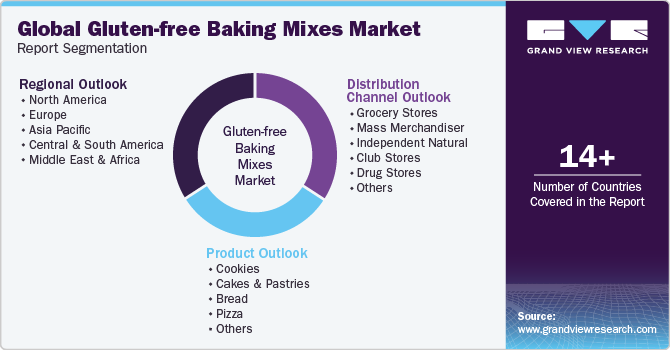
-
Product Outlook (Revenue, USD Million, 2018 - 2030)
-
Cookies
-
Cakes & Pastries
-
Bread
-
Pizza
-
Others
-
-
Distribution Channel Outlook (Revenue, USD Million, 2018 - 2030)
-
Grocery Stores
-
Mass Merchandiser
-
Independent Natural or Health Food Store
-
Club Stores
-
Drug Stores
-
Others
-
-
Regional Outlook (Revenue, USD Million, 2018 - 2030)
-
North America
-
U.S.
-
Canada
-
Mexico
-
-
Europe
-
U.K.
-
Germany
-
France
-
Italy
-
-
Asia Pacific
-
Australia
-
China
-
India
-
New Zealand
-
-
Central & South America (CSA)
-
Brazil
-
-
Middle East & Africa (MEA)
-
South Africa
-
-
Frequently Asked Questions About This Report
b. The global gluten-free baking mixes market size was estimated at USD 481.9 million in 2023 and is expected to reach USD 518.0 million in 2024.
b. The global gluten-free baking mixes market is expected to grow at a compounded growth rate of 7.8% from 2024 to 2030 to reach USD 815.2 million by 2030.
b. The cookies segment accounted for the largest revenue share of 32.6% in 2023 and is anticipated to maintain its dominance over the forecast period. Rising popularity of cookies among toddlers, children, millennials, and even the working population as a snack, is the major factor driving the growth of this segment. Furthermore, cookies are also gaining traction as a gifting option during celebrations and festivals such as Christmas, New Year, and Thanksgiving favoring the segment growth.
b. Some key players operating in the gluten-free baking mixes market include General Mills Inc.; Conagra Brands, Inc.; Kinnikinnick Foods Inc.; Williams-Sonoma Inc.; Continental Mills, Inc.; Partake Foods; Chebe; Naturpro; King Arthur Baking Company, Inc.; and SalDolce Fine Foods.
b. The cookies product segment accounted for the largest revenue share of over 32% in 2023 and is anticipated to maintain its dominance over the forecast period in the gluten-free baking mixes market.
b. The grocery stores segment accounted for the largest revenue share of more than 63% in 2023 in the gluten-free baking mixes market.
Share this report with your colleague or friend.
![gvr icn]()
NEED A CUSTOM REPORT?
We can customize every report - free of charge - including purchasing stand-alone sections or country-level reports, as well as offer affordable discounts for start-ups & universities. Contact us now
![Certified Icon]()
We are GDPR and CCPA compliant! Your transaction & personal information is safe and secure. For more details, please read our privacy policy.
We are committed towards customer satisfaction, and quality service.
"The quality of research they have done for us has been excellent."





